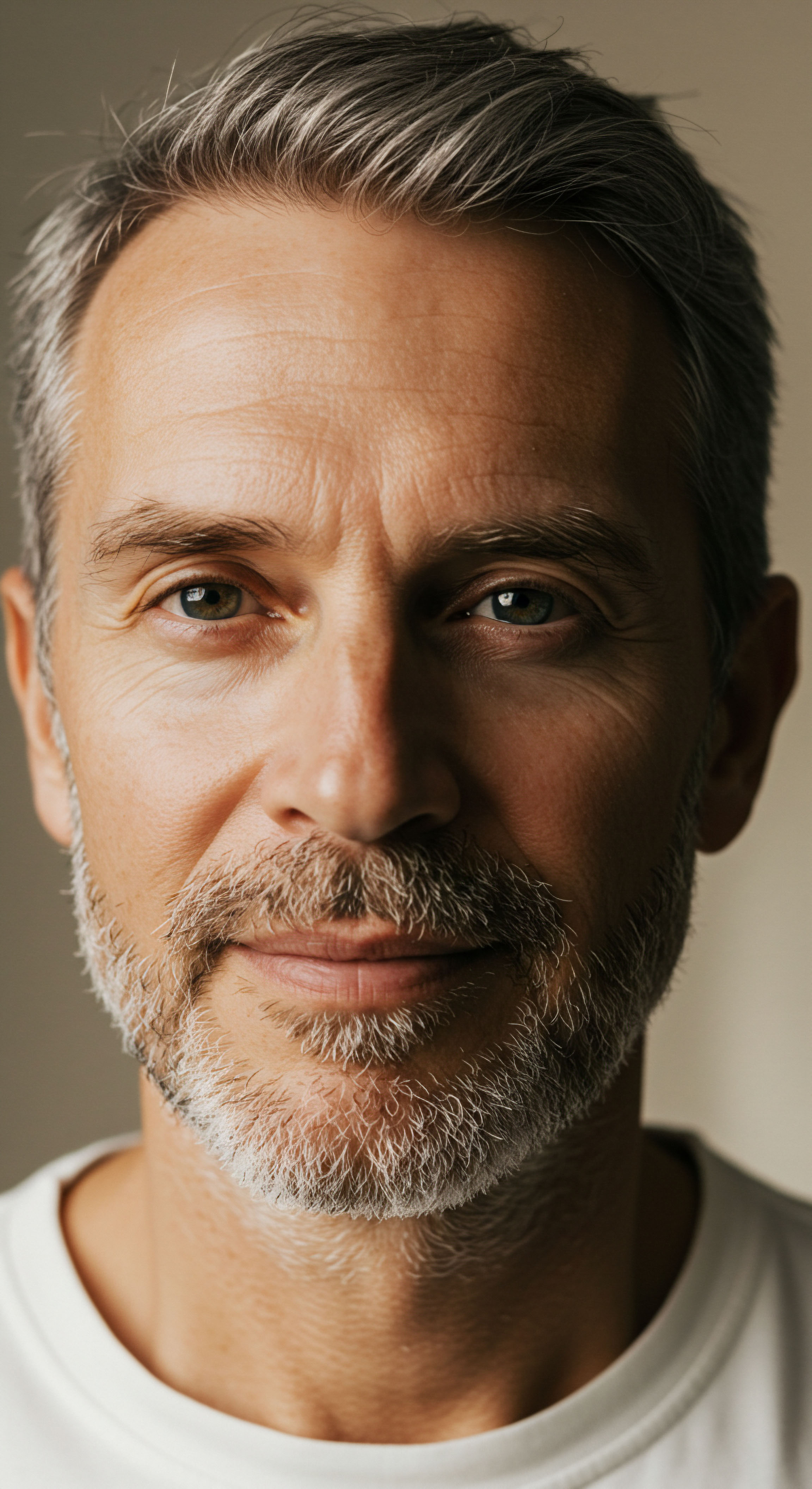

Fundamentals
You may be considering or already undergoing a form of male sexual health therapy, such as Testosterone Replacement Therapy (TRT), and find yourself asking a deeply personal question ∞ Why are my results not what I expected? You feel the frustration of investing time, hope, and resources into a clinical protocol, only to feel that its full promise remains just out of reach.
The experience of your body not responding as you anticipated is a valid and frequent concern. The answer begins with a shift in perspective, moving from viewing the body as a simple machine where a single part can be replaced to seeing it as a complex, interconnected ecosystem.
Your daily choices, the very fabric of your lifestyle, create the environment in which these therapies must operate. They are the soil, the climate, and the foundation upon which any therapeutic structure is built. A protocol’s success is profoundly dependent on the biological terrain it encounters.
Imagine your body’s vascular network as an intricate system of highways. For an erection to occur, these highways must be wide open, allowing for a rapid and sustained flow of traffic ∞ in this case, blood. Therapies can act like dispatchers, sending the right signals to initiate this process.
Yet, if the highways themselves are congested and inflamed, the signals become ineffective. This is where lifestyle enters the picture. Choices related to diet and body composition directly influence this internal infrastructure. A diet high in processed foods can contribute to a state of chronic, low-grade inflammation throughout the body.
This inflammation generates substances that actively work against nitric oxide, the molecule responsible for relaxing blood vessels to allow for increased blood flow. When you are overweight, particularly with excess visceral fat around your organs, this inflammatory state is amplified, further compromising the vascular system that is essential for sexual function. Managing your weight and adopting a nutrient-dense diet are foundational acts of clearing these biological roadways, allowing therapeutic signals to travel unimpeded.
Your body’s overall health provides the essential foundation that determines how effectively any sexual health therapy can perform.
Physical activity serves a dual purpose in this ecosystem. Firstly, consistent exercise, especially cardiovascular work like running or swimming, strengthens the heart’s ability to pump blood efficiently through the entire vascular network. Better circulation means that when the body receives a signal for an erection, the delivery system is robust and responsive.
Secondly, resistance training helps build lean muscle mass, which improves insulin sensitivity. Improved insulin sensitivity means your body is better at managing blood sugar, a process that, when dysfunctional, is closely linked to inflammation and vascular damage. Exercise is a direct investment in the mechanical and metabolic machinery required for sexual health. It prepares the body to respond optimally to therapeutic interventions.
The influence of your mental and emotional state on your physical body is powerful and biochemically real. Chronic stress prompts the body to release high levels of cortisol, a hormone designed for short-term, fight-or-flight situations. When stress becomes a constant presence, elevated cortisol continually signals your blood vessels to constrict.
This action directly opposes the vasodilation required for an erection. Even a perfectly optimized hormonal protocol can struggle to overcome a vascular system that is being perpetually clamped down by stress. Stress management, therefore, is not a soft skill in this context; it is a physiological necessity.
Practices like meditation, deep breathing, or even engaging in hobbies can lower cortisol, relaxing the vascular system and making it more receptive to pro-erectile signals. Similarly, adequate sleep is when the body repairs itself and regulates its hormonal systems, including the balance between cortisol and testosterone. Without sufficient sleep, the body remains in a stressed, catabolic state, undermining the restorative goals of therapy.
Finally, substances like alcohol and tobacco introduce external factors that can disrupt the body’s delicate balance. Smoking directly damages the endothelial lining of blood vessels, accelerating the inflammatory processes that restrict blood flow. Excessive alcohol consumption can impair erectile function in both the short and long term, affecting everything from nerve function to hormonal balance.
Reducing or eliminating these substances removes significant obstacles from the path of therapeutic success. Each of these lifestyle factors ∞ diet, exercise, stress, sleep, and substance use ∞ collectively shapes your body’s internal environment.
They determine whether a given therapy is introduced into a system that is resilient, responsive, and ready for change, or one that is burdened by inflammation, vascular constriction, and metabolic dysfunction. The therapy itself is a key, but your lifestyle determines how easily that key will turn in the lock.


Intermediate
For individuals engaged with specific clinical protocols, understanding the direct biochemical interplay between lifestyle and therapy is the next logical step. The effectiveness of treatments like Testosterone Replacement Therapy (TRT) or peptide-based protocols is not determined in a vacuum. These interventions are sophisticated signals introduced into a complex biological conversation.
Your lifestyle choices act as powerful modulators of this conversation, capable of amplifying or dampening the intended therapeutic message. Acknowledging this dynamic allows you to transition from a passive recipient of a protocol to an active participant in its success, shaping your physiology to be exquisitely receptive to treatment.

How Does Insulin Resistance Directly Impair Testosterone Therapy?
One of the most significant ways lifestyle modulates hormonal therapy is through its effect on insulin sensitivity. A diet high in refined carbohydrates and a sedentary lifestyle can lead to insulin resistance, a state where your cells become less responsive to the hormone insulin. This condition has profound implications for a man on TRT.
Firstly, the visceral adipose tissue that often accumulates with insulin resistance is a primary site of the enzyme aromatase. Aromatase converts testosterone into estradiol, a form of estrogen. In a state of insulin resistance and obesity, a significant portion of the testosterone administered through TRT can be immediately converted into estrogen.
This process not only reduces the amount of effective testosterone available to bind to androgen receptors but also elevates estrogen levels, potentially leading to side effects like water retention and gynecomastia. Consequently, a patient with poor metabolic health may require higher doses of anastrozole, an aromatase inhibitor, to manage these side effects, adding complexity and potential complications to the protocol.
Secondly, insulin resistance is intertwined with levels of Sex Hormone-Binding Globulin (SHBG), a protein that binds to testosterone in the bloodstream, rendering it inactive. High insulin levels tend to suppress SHBG production by the liver. While this might sound beneficial, as it could lead to more “free” testosterone, the reality is more complex.
The underlying metabolic dysfunction, inflammation, and elevated aromatase activity create an environment where the hormonal balance is still skewed and overall receptor sensitivity is compromised. Improving insulin sensitivity through a low-glycemic diet and regular exercise can help normalize SHBG levels and, more importantly, reduce the inflammatory and aromatizing environment, allowing the administered testosterone to function more effectively within a balanced endocrine system.
Lifestyle choices directly influence the biochemical environment, determining how much of a therapeutic dose of testosterone is converted to estrogen or is available to the body’s cells.
The following table illustrates how two different lifestyle profiles can dramatically alter the outcomes of a standard TRT protocol:
| Metric | Patient A ∞ Optimized Lifestyle | Patient B ∞ Suboptimal Lifestyle |
|---|---|---|
| Diet & Exercise |
Low-glycemic diet, consistent resistance training and cardio. |
High-carbohydrate diet, sedentary. |
| Body Composition |
Low visceral fat, healthy body fat percentage. |
High visceral fat, obese. |
| Aromatase Activity |
Low. Minimal conversion of testosterone to estradiol. |
High. Significant conversion of testosterone to estradiol. |
| Anastrozole Requirement |
Low to none. Estrogen levels remain in a healthy range naturally. |
High. Requires active management to prevent estrogenic side effects. |
| Insulin Sensitivity |
High. Efficient glucose metabolism and low inflammation. |
Low (Insulin Resistant). High inflammation and metabolic stress. |
| Subjective Well-being |
Reports stable energy, mood, and libido. Feels the full benefit of the therapy. |
Reports fluctuating energy, mood swings, and water retention. Feels therapy is not working. |

Modulating the Effectiveness of Advanced Therapies
This principle of lifestyle as a modulator extends to other advanced therapies. Growth hormone peptides like Sermorelin or CJC-1295/Ipamorelin work by stimulating your pituitary gland to release its own growth hormone (GH). This release happens in pulses, and the strength of these pulses can be significantly blunted by high insulin levels.
If an individual consumes a high-sugar meal before administering these peptides, the resulting insulin spike can inhibit the GH release, rendering the therapy far less effective. To maximize the benefit of these peptides, they are best administered in a fasted state, a direct manipulation of lifestyle to create an optimal hormonal environment.
Even therapies targeting the central nervous system, like PT-141 (Bremelanotide) for sexual arousal, are influenced by your systemic health. PT-141 functions by activating melanocortin receptors in the brain, which are involved in dopamine pathways related to sexual desire. Chronic stress, poor sleep, and a nutrient-poor diet can dysregulate these same neurotransmitter systems.
A brain and body under high allostatic load ∞ the cumulative wear and tear from chronic stress ∞ will have a less robust response to this type of stimulation. The therapy may still work, but its effect will be muted compared to its potential in a well-rested, well-nourished, and low-stress individual.
To prepare your body for and enhance the effectiveness of these therapies, a targeted lifestyle approach is essential. The goal is to reduce systemic inflammation, improve insulin sensitivity, and balance the autonomic nervous system. The following actions create a physiological foundation for success:
- Dietary Prioritization ∞ Adopt a diet rich in whole foods, healthy fats, quality proteins, and fiber, such as a Mediterranean-style eating pattern. This directly combats the inflammation and insulin resistance that can derail hormonal therapies.
- Strategic Exercise ∞ A combination of resistance training to build muscle and improve insulin sensitivity, along with high-intensity interval training (HIIT) or steady-state cardio to enhance cardiovascular health, creates a metabolically flexible and responsive body.
- Stress and Cortisol Regulation ∞ Implement a consistent practice to manage stress, such as daily mindfulness meditation, breathwork, or spending time in nature. This helps lower the chronic cortisol production that suppresses the HPG axis and constricts blood vessels.
- Sleep Optimization ∞ Prioritize 7-9 hours of quality sleep per night. This is when the body undergoes critical hormonal regulation and physical repair, processes that are fundamental to getting the most out of any regenerative or hormonal protocol.


Academic
A sophisticated analysis of how lifestyle factors influence male sexual health therapies requires a deep examination of the crosstalk between the body’s major regulatory systems. The effectiveness of exogenous hormonal interventions, such as Testosterone Replacement Therapy (TRT), or endogenous stimulating protocols, like the use of Gonadorelin or growth hormone secretagogues, is fundamentally dependent on the functional integrity of the recipient’s underlying biology.
The dominant modulating variable in this equation is the interplay between the Hypothalamic-Pituitary-Gonadal (HPG) axis, which governs sexual hormone production, and the Hypothalamic-Pituitary-Adrenal (HPA) axis, the central stress response system. Lifestyle choices are the primary drivers that dictate the chronic state of activation and balance between these two deeply interconnected axes.

What Is the Molecular Link between Adipose Tissue Inflammation and Aromatase Activity?
Chronic psychological, metabolic, and inflammatory stress, often a direct result of lifestyle factors such as poor diet, sedentary behavior, and inadequate sleep, leads to a state of sustained HPA axis activation. This results in the chronic elevation of glucocorticoids, principally cortisol.
From a teleological perspective, the body interprets this chronic stress as a threat to survival, leading to a downregulation of non-essential, energy-intensive processes like reproduction. Cortisol exerts this suppressive effect at multiple levels of the HPG axis. At the apex, it directly inhibits the pulsatile release of Gonadotropin-Releasing Hormone (GnRH) from the hypothalamus.
This reduction in GnRH signaling leads to decreased synthesis and release of Luteinizing Hormone (LH) and Follicle-Stimulating Hormone (FSH) from the anterior pituitary. The subsequent reduction in LH stimulation of the testicular Leydig cells results in suppressed endogenous testosterone production.
Therefore, an individual initiating TRT in a state of high allostatic load is introducing testosterone into a system that is being actively suppressed by a competing biological imperative. While the therapy can elevate serum testosterone levels, it does not resolve the underlying suppressive signaling from the HPA axis, which can manifest as a muted or incomplete symptomatic response.
The molecular link between lifestyle-induced obesity and the efficacy of androgen therapy is centered on the biology of adipose tissue. Visceral adipose tissue is not a passive storage depot; it is a highly active endocrine organ.
In obese individuals, adipocytes become hypertrophic and dysfunctional, leading to a state of chronic, low-grade inflammation characterized by the infiltration of macrophages and the secretion of pro-inflammatory cytokines like TNF-α and IL-6. These cytokines have a profound impact on local and systemic physiology.
Crucially, TNF-α and IL-6 act as potent inducers of aromatase (CYP19A1) expression in both adipocytes and surrounding stromal cells. This creates a vicious cycle ∞ increased adiposity leads to increased inflammation, which in turn drives higher aromatase activity. Higher aromatase activity leads to the peripheral conversion of testosterone and other androgens into estrogens.
For a patient on TRT, this means a significant portion of the therapeutic dose is shunted away from the intended androgenic pathways and towards estrogenic pathways, fundamentally altering the therapeutic androgen-to-estrogen ratio and undermining the goals of treatment.

Can Lifestyle Changes Reverse Endothelial Dysfunction at the Cellular Level?
The final common pathway for erectile function is vascular. An erection is a hemodynamic event dependent on the relaxation of smooth muscle in the corpora cavernosa and the dilation of penile arteries, mediated primarily by nitric oxide (NO). The enzyme responsible for producing the majority of NO in the vasculature is endothelial nitric oxide synthase (eNOS).
The efficacy of any sexual health therapy, whether hormonal or not, is ultimately constrained by the health of the endothelium. Lifestyle factors are the principal determinants of endothelial function.
A diet high in saturated fats and refined sugars, combined with a sedentary lifestyle, promotes a state of oxidative stress and systemic inflammation. Reactive oxygen species (ROS) generated in this state directly scavenge NO, reducing its bioavailability. Furthermore, pro-inflammatory cytokines inhibit the expression and activity of eNOS.
The result is endothelial dysfunction, a condition where the blood vessels lose their ability to properly dilate. Introducing a therapy like TRT, which can have positive effects on NO production, into a system crippled by endothelial dysfunction is like pressing the accelerator in a car with clogged fuel lines.
The signal is sent, but the mechanical capacity to respond is severely impaired. Conversely, lifestyle interventions such as regular aerobic exercise have been shown to increase eNOS expression and activity through shear stress, while diets rich in antioxidants and polyphenols can reduce oxidative stress and improve NO bioavailability.
These interventions directly restore the functional capacity of the endothelium, allowing the vascular system to respond robustly to pro-erectile stimuli, whether they originate from endogenous nerve signals or are supported by hormonal therapy.
The interplay between the HPA and HPG axes, modulated by lifestyle, dictates the hormonal and metabolic background upon which all sexual health therapies must act.
The following table provides an academic overview of how specific lifestyle interventions can impact key biomarkers that are critical for the success of male sexual health therapies.
| Lifestyle Intervention | Biomarker | Mechanism of Action | Impact on Therapy Efficacy |
|---|---|---|---|
| Resistance Training (12 weeks) |
SHBG / Free Testosterone |
Increases lean muscle mass, improves insulin sensitivity, which can modulate SHBG levels and improve testosterone utilization by tissues. |
Enhances the efficiency of TRT by improving the body’s ability to use available testosterone. |
| Aerobic Exercise (4x/week) |
eNOS Expression |
Increases vascular shear stress, which upregulates endothelial nitric oxide synthase (eNOS) gene expression and protein activity. |
Improves the fundamental vascular capacity for erection, amplifying the benefits of any pro-erectile therapy. |
| Mediterranean Diet |
hs-CRP (high-sensitivity C-reactive protein) |
Reduces systemic inflammation through high intake of polyphenols, omega-3 fatty acids, and reduced intake of processed foods. |
Lowers inflammation-driven aromatase activity and reduces oxidative stress, creating a more favorable environment for TRT. |
| Sleep Optimization (7-9 hours) |
Morning Cortisol |
Restores normal circadian rhythm of the HPA axis, preventing chronic cortisol elevation. |
Reduces the suppressive effect of cortisol on the HPG axis, allowing therapies like Gonadorelin to work more effectively. |
The molecular cascade from lifestyle choice to therapeutic outcome is precise and demonstrable. A comprehensive approach to male sexual health must therefore address these foundational factors. The following steps outline the physiological progression from a stressor to impaired therapeutic response:
- Chronic Stressor ∞ A lifestyle characterized by poor nutrition, lack of sleep, and psychological stress is perceived by the central nervous system as a persistent threat.
- HPA Axis Activation ∞ The hypothalamus releases CRH, stimulating the pituitary to release ACTH, which in turn causes the adrenal glands to secrete cortisol.
- HPG Axis Suppression ∞ Elevated cortisol directly inhibits GnRH release at the hypothalamus, leading to reduced LH/FSH and suppressed testicular function.
- Metabolic Dysregulation ∞ Concurrently, these lifestyle factors promote insulin resistance and visceral fat accumulation.
- Inflammation and Aromatization ∞ Adipose tissue becomes inflamed, secreting cytokines that dramatically increase the activity of the aromatase enzyme.
- Endothelial Dysfunction ∞ Systemic inflammation and oxidative stress reduce nitric oxide bioavailability and impair the ability of blood vessels to dilate.
- Compromised Therapeutic Outcome ∞ An administered therapy (e.g. TRT) now enters a system that is actively suppressing its own androgens, converting the therapeutic agent to estrogen, and is unable to mechanically respond to pro-erectile signals due to vascular damage.
In conclusion, from an academic standpoint, lifestyle factors are not merely adjuncts to male sexual health therapies; they are the determinants of the physiological context in which these therapies operate. A failure to address the underlying lifestyle-driven dysregulation of the HPA axis, metabolic health, and endothelial function will invariably lead to a suboptimal clinical outcome.

References
- Meston, Cindy M. and Amelia S. Stanton. “Treatment of Male Sexual Dysfunction.” UT Psychology Labs, University of Texas. Accessed July 2024.
- Salonia, A. et al. “Lifestyles and sexuality in men and women ∞ the gender perspective in sexual medicine.” Journal of Endocrinological Investigation, vol. 43, no. 2, 2020, pp. 1-13.
- “Six lifestyle changes a man can make to improve sexual function.” University of Iowa Health Care, 2022.
- Allen, Mark S. and Elizabeth E. Walter. “Health-Related Lifestyle Factors and Sexual Dysfunction ∞ A Meta-Analysis of Population-Based Research.” The Journal of Sexual Medicine, vol. 15, no. 4, 2018, pp. 458-475.
- “Cortisol And Erectile Dysfunction ∞ The Hidden Link.” Allo Health, 2024.

Reflection

Charting Your Own Biology
The information presented here offers a map of the intricate biological systems that govern male vitality. It details the mechanisms, the pathways, and the powerful influence of daily life on sophisticated clinical protocols. This knowledge provides a framework for understanding the ‘why’ behind your personal experience.
It validates the feeling that something more than just a single hormone level is at play. Your body is a responsive, dynamic entity, constantly adapting to the signals you provide through nutrition, movement, rest, and thought.
Understanding these connections is the foundational step. The next is to apply this map to your own unique terrain. The principles are universal, but their application is deeply personal. Your journey toward optimal function is not about adhering to a rigid, one-size-fits-all mandate.
It is about beginning a period of self-study, of observing how your body responds to change. It is about cultivating an awareness of your own internal feedback loops. This process of discovery, of learning the specific dialect your body speaks, is where true empowerment lies. The goal is to move forward not just with a protocol, but with a partnership ∞ a collaborative effort between you, your clinical team, and the profound intelligence of your own biology.



